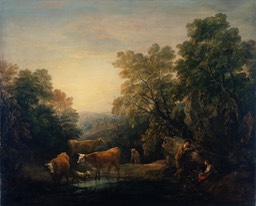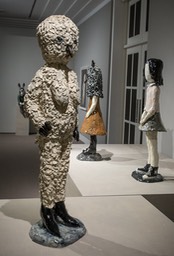Visual arts review: ‘Pastures Green, & Dark Satanic Mills: The British Passion for Landscape’ at the Norton Museum of Art
3/1/15
The landscape genre falls within most viewers’ comfort zone. There won’t be spilled viscera, terrifying grimaces, jolting automatons or other assaults on delicate sensibilities. Fittingly, the Norton Museum of Art’s exhibition,Pastures Green, & Dark Satanic Mills: The British Passion for Landscapeoffers pristine skies, pastures and lakes, but those “dark satanic mills” do project shadows.
Encompassing works from the 1660s to the early 2000s, these 65 paintings (mostly) present a specific focus on man’s place in nature, shedding light on social and environmental issues. The exhibition was curated by Tim Barringer from Yale University and Oliver Fairclough, Keeper of Art at the National Museum Wales. It draws exclusively from the Welsh museum’s extensive collections.
Cheryl Brutvan, the Norton’s director of curatorial affairs, arranged and installed the works to best utilize the museum’s architecture and gallery spaces “to illustrate the curatorial view.” In one room this highlights coherence and distinctions among works from a historical period. At another key location, the viewer can telescope the wide visual, historical and emotional sweep of the exhibition by scanning across four paintings.
The first room presents the work of several giants of the “Classical Vision”that initiate six thematic sections. Large oils by Claude Lorrain and Salvator Rosa start the show. Lorrain’s Landscape with St. Philip Baptizing the Eunuch depicts a biblical anecdote, staged in a stately, idealized natural setting. It contrasts with Salvator Rosa’s hauntingly dramatic Rocky Landscape with Herdsmen and Cattle. Their stylistic differences are spotlighted by Jerry Dobrick, curatorial associate for European art. “Claude really was interested in creating a beautiful composition, so he was more using the imagination, rather than looking at a realistic landscape,” Dobrick says. “He more or less photoshopped together elements that would be taken from different aspects in the landscape and put them together for a pleasing, harmonious composition.”
His contemporary Rosa also created an imaginary view of nature. But whereas Lorrain’s compositions are formally framed by trees and gradually recede into distant vistas, “Rosa enjoyed the more spectacular and terrifying and a lot less calming effect in landscape. He liked jagged rocks; he liked trees that were splintered; he liked putting people into these strange landscapes,” said Dobrick. Both artists were highly collected — even in their own day — each with his own fan base.
This “dueling pair’s” works date from the 1660s and 1670s. They converse with a large Gainsborough from a hundred years later. Rocky Wooded Landscape with Rustic Lovers, Herdsman, and Cows, is gently nostalgic; however, while no mood-breaking structures are present, the couple is rather fashionably attired for “rustics.”
With his large watercolor of Wales’ famous 12th-century Caernarvon Castle, Thomas Girtin represents the documentary-like topographic tradition. Much as Romans had looked to Greece for antiques, wealthy 18th-century European tourists snapped up souvenir views of picturesque sights. Before shifting to the moodier, dramatic style of the exhibition’s theme of the Sublime, William Turner was a Girten rival and also painted views of watermills, bridges, castles and church interiors, including many sketched during his tours of Wales. These works elevated the status of watercolor from preparatory study to finished exhibition piece.
One quirky highlight is a satiric work by Thomas Rowlandson, whose hand-colored etching/aquatint caricaturizes an overdressed, over-geared artist-adventurer. This awkward figure, unsteadily mounted on a diminutive horse, heads into the rain, seeking to “bag” a unique view.
Throughout the show, the A-listers are joined by strong examples by other artists who amplify the themes and expand the range of approaches to the genre.
The section Turner and the Sublime offers a fine mini-retrospective. Selections span his range of subject, tone and technique. Transept of Ewenny Priory, Glamorganshire demonstrates prodigious pictorial accuracy, selective focus and evocative tone. Later works include his bread-and-butter subjects and majestic expanses of sky, mountain and water, overwhelming diminutive figures. Nature’s supremacy is also conveyed in Edward Lear’s exotic Himalayan vista, the Christian mysticism of Henry Clarence Whaite and — in its dark side — by Turner’s almost abstract storm and shipwreck. As Dobrick explained, these artists felt that “You should observe it [nature] as halfway between stepping into the abyss and stepping into the sublime.”
Truth to Nature offers many interpretations of this ambiguous phrase. In Stanley Spencer’s Snowdon from Llanthrothen, the harsh linear streak of a modern roadway slices across a timeless jumble of rock walls, patchwork fields and wild thickets. Thomas Jones’ painting is another gem. Offering nary a leaf, branch nor human form, his stark, boldly sunwashed and timeworn foreground wall contrasts with a monochromatic, reductionist background to create a surprisingly modern interpretation of Naples — in 1782!
Photography raises questions about the artist’s role in capturing a likeness of the physical world with the “imperfect” tools of brush and pigment. Mid-19th-century calotype photographic prints by Calvert Richard Jones, Roger Fenton and John D. Llewelyn show popular churches, castles and cliffs, but Jones’ Three Canals, Brecon foreshadows industrialization with its riverside crane.
Within the next section, Picturing Modernity, depictions of contemporary “wonders” — the lifeless chasm of an open-pit copper mine — for example, contrast with the natural wonders, seen earlier.
The Industrial Revolution, which began in late 18th-century Britain, is central to the moral heart of the exhibition. By degrading land, air and water — along with boosting both wealth and poverty — this socio-economic phenomenon inspired artists to go outdoors. Both near to home and in excursions abroad, they drew and painted sea, city and landscape — as observers, experimenters and sermonizers.
London grew from 1 million to more than 6 million residents during the course of the 19th century. The city, its sky and the picturesque Thames River were buried beneath smoke and traffic. Wales was another steel and coal capital.
Lionel Walden’s moody, dramatic Steelworks Cardiff at Night captures the factory in full swing in 1895, when it was the largest steelworks in the world. According to Dobrick, “It’s as much a capturing of industrialization as Claude’s paintings were of the landscape in classical Italy.”
Its bold smokestacks could be likened to the columns supporting industrialization. Walden was obviously in awe; he knew he was capturing an historic moment and gave his painting to the Wales museum. Dobrick calls this work “an operatic spectacle.”
Nearby is Oscar Kokoschka’s expressionistic London — Waterloo Bridgefrom 1926. It shows the Thames with the bridge in the foreground and St. Paul’s Cathedral in the upper left. “It’s alive with energy, and Kokoschka captures that in the manner and style of the painting and also the palette of the painting,” Dobrick said.
“As opposed to the Walden painting, which is dark and sinister, this is completely light and bright and almost has white frosting pieces in it here and there.
“Looking at his work, it was very much influenced by Monet and the Impressionists as well as Turner, because not only of the subject of Waterloo Bridge, which they both painted (Turner painted it as well as Monet), but also the drama, the palette and the immediacy of the work.”
In contrast to the studied procedures of academic picture-making, Impressionists focused on the optics of visual perception and the recording of the immediate … impression. This approach is well represented in both oils and watercolors by Claude Monet’s hazy blue-violet meditation on London’s Charing Cross bridge, by Alfred Sisley’s Welsh coast painting, Léon de Smet’s Waterloo Bridge and a handful of top-flight English and Welsh artists.
We don’t see the devastation of World War I — neither on cities, nor on the landscape. Among the exhibition’s selections of Impressionist and Post-Impressionist works, Charles Sims, Christopher Williams and Laura Knight dispose their figures in settings suitable for picnics, rather than in the war scenes they or their contemporaries also painted. Their sunny landscapes offer respite from the bleaker aspects of life.
In the final “Neo-Romantic to Post-Modern” section, Evelyn Dunbar’s 1940Baling Hay references World War II. The British Ministry of Information created an agency to document the war, raise morale and extol national culture. Here, the bucolic setting is subverted by mechanical equipment that dwarfs the six working women; glowering skies cast a pall over their heroic efforts.
By contrast, the romantic key is strongly embodied in Samuel Palmer’s idyllic scene. A follower of the poets Blake and Milton, he painted in London but extolled the pre-industrial village life of his youth. This idiosyncratic thematic section encompasses many styles, including such curious compositions as Cedric Morris’ 1940 charmer, in which a pair of Rousseau-like birds miniaturize the Stoke-by-Nayland church of the painting’s title.
The curators selected 20th-century landscape painters who incorporate surrealist, symbolist and expressionist influences in very personal ways. We find suggestions of upheaval in John Minton’s dark post-war Welsh Landscape, John Piper’s romantic search for unspoiled sylvan beauty in the Welsh hinterlands and, decades later, the bright-hued optimism of Frank Auerbach’s vigorous brush drawing of a London park.
Man’s despoilment of nature — specifically coal-mining runoff — is vividly conveyed by Jack Crabtree’s Polluted Pool at Maindee. He uses poisonous greens and a fascinating mix of realistic and phantasmagorical elements, like a goggled face at the bottom of the dream-like composition.
The exhibition reaches the 21st century with a set of intriguing photographs. David Nash’s 30-year-long tree planting, pruning and photo-documentation project embodies his optimistic immersion in long-term environmental processes.
Snowdonia Stones marks Richard Long’s self-conscious passage through the hallowed Welsh landscapes memorialized by prior generations of artists. Erecting a set of stele-like stones, he sensitively commemorates his shared affection for the timeless landscape and all it represents.
Klara Kristalova
Also on view: Klara Kristalova is the fourth artist honored by the Norton’sRecognition of Art by Women (RAW) exhibition series. Her haunting glazed ceramic sculptural works share a disturbing and seductive appeal with her watercolors and drawings. Perhaps the long, snow-filled arctic nights that cloak the artist’s Swedish studio provide the fertile growth medium for her charming, visceral and frightening fantasies. Animal-like humans are interspersed with child-like animals, both seemingly capable of violence. The artist acknowledges myths and storytelling as elements of her inspiration, but the specific touch of her fingers and brush provide their tangible animation.
Listen to curator’s commentary at bitly.com/PasturesGreen.
If you go
What: ‘Pastures Green & Dark Satanic Mills: The British Passion for Landscape’
When: Through April 5
Where: Norton Museum of Art, 1451 South Olive Ave., West Palm Beach
Cost: $5 to $12 (Children under 12 free)
Info: 561-832-5196 or www.norton.org
And
What: ‘Klara Kristalova: Turning into Stone’
When: Through March 29
See website for additional exhibitions

